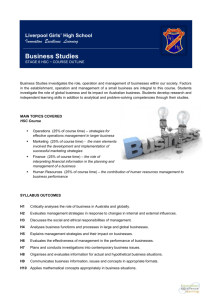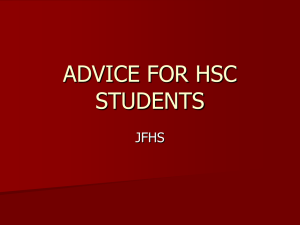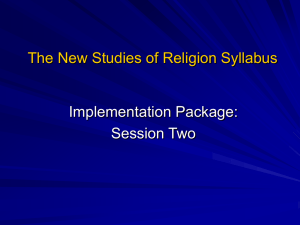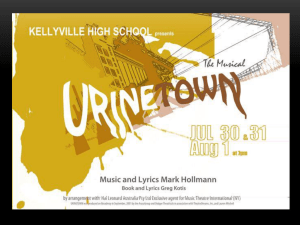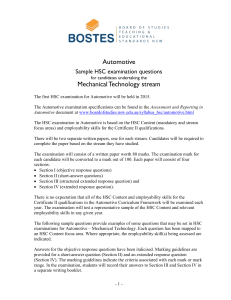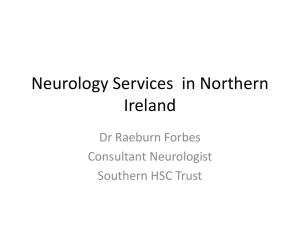Deconstructing Exam Questions
advertisement
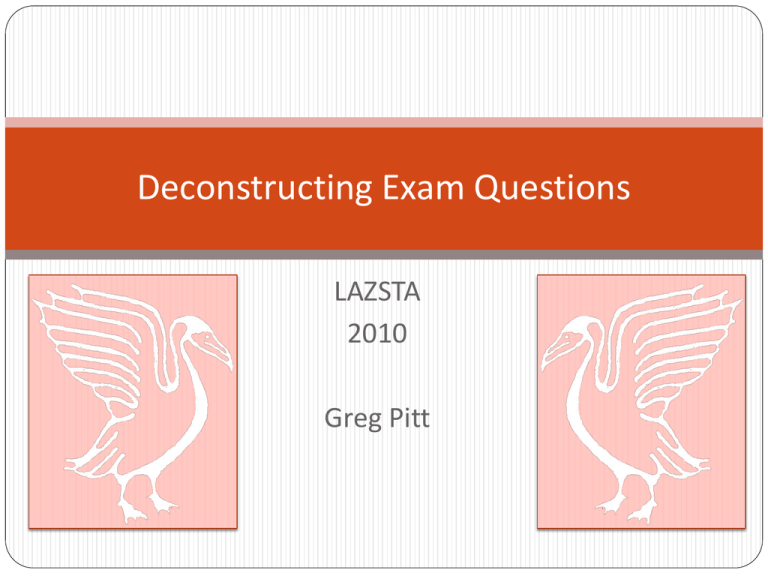
Deconstructing Exam Questions LAZSTA 2010 Greg Pitt Changes to the HSC beginning in 2010 Section I Part A Part B 20 marks – 20 multiple choice (Note this change) 55 marks – Written response (Extended answer) Section II 25 marks – Option (one from the following) - Polymers - Preservatives and Additives - Pharmaceuticals - Disasters - Space Science HSC Timetable 2010 Download from http://www.boardofstudies.nsw.edu.au/events/ BOS – Important notice Question 19 (2009 HSC) HSC Outcomes – A student… Outcomes-related questions [Outcome H2] (a) Explain the effect of pulling down on the rubber sheet. (2M) (b) Outline why models, such as the one shown, are used in science. (2M) Outcomes-related questions [Outcome H2] (a) (b) Explain the effect of pulling down on the rubber sheet. (2M) Outline why models, such as the one shown, are used in science. (2M) HSC 2009 Question 20 (6 marks) Describe the beneficial and detrimental effects of soaps and soapless detergents on the environment. (6M) HSC 2009 Question 20 (6 marks) Describe the beneficial and detrimental effects of soaps and soapless detergents on the environment. (6M) HSC 2009 Question 27 (6 marks) A fax machine firstly converts an image into information. The information is transmitted through a copper wire and then transmitted using an optical fibre. Describe the processes that take place at each of these three steps. HSC 2009 Question 27 (6 marks) A fax machine firstly converts an image into information. The information is transmitted through a copper wire and then transmitted using an optical fibre. Describe the processes that take place at each of these three steps. Sample answer: The document is scanned by a beam of light along very thin lines. The light reflects differently from different marks on the page. The reflected light is detected by a photocell. The photocell converts the incident light into electrical voltages. This signal carriers information along a copper wire. For optical fibre, the electrical energy is converted to light for transmission, and the signal is digitally encoded. HSC 2008 – Question 23 Discuss the use of visible light in communication systems. (6M) HSC 2008 – Question 23 Discuss the use of visible light in communication systems. (6M) Visible light can be used in simple communication systems such as traffic lights and lighthouses. The advantages of using light in such communication systems are that light travels at very high speeds and the information is sent virtually instantaneously. The ability of light to be reflected allows the information to be sent through underground cables between the source and destination. One disadvantage of light is that it cannot always be used to transmit information through the atmosphere during the day due to interference with natural light. This is why lighthouses only operate at night-time. HSC 2007 – Question 19 Question 19 (5 marks) Relate the properties of pesticides and body hygiene products to the precautions needed when using and handling each type of chemical. Notes from the markers: Better responses identified precautions to follow when using both these types of chemicals and then related them to specific properties of pesticides and of body hygiene products. The weakest responses only included precautions with little or no mention of properties of either type of chemical. HSC 2007 – Question 24 (b) Explain reasons for the increased use of fibre optics in communication. (4 marks) Reasons – two examples Greater data carrying capacity Reduced cost (per megabyte of data) Explanation Greater data carrying capacity is possible because using light (IR), it is possible to switch the light on and off (hence binary code) at extremely high frequencies and hence more data bits per second. Reduced cost (per megabyte of data) has happened because each fibre can carry more data per second and many fibres can be laid simultaneously at little extra cost (redundancy for future). HSC 2007 – Question 25 Relate TWO properties of microwaves to their use in communication through air and space. (4 marks) Two properties of microwaves Travel very fast – at the speed of light Travel through a vacuum as well as the air Relationship between property and use Travel very fast – this makes almost instantaneous communication possible between points on Earth and to/from satellites in orbit around the Earth. Travel through a vacuum as well as air – this makes it possible to communicate using satellites as well as through the air making mobile phone communication possible. HSC 2007 – Question 27 Assess the impacts that changes in communication systems have had on society. (6 marks) HSC 2006 – Question 18 (b) Explain why knowledge of the solubility of materials is important to the way medications are administered. (4 marks) HSC 2006 – Question 26 Technological advances have enabled human communication to change from methods that were mainly used over short distances, to a range of systems that allows worldwide communication to occur. Analyse the relationship between the development of worldwide communication systems and the changes that these systems have produced in society. (7 marks) Mandatory First-hand Investigations • perform a first-hand investigation to observe ways in which waves can be modulated to carry different types of information (Syllabus dot point) Q27 2002 HSC Mandatory Investigations • perform a first-hand investigation to observe ways in which waves can be modulated to carry different types of information (Syllabus dot point) Deconstructing a Question Relate cause and effect; make the relationships between things evident; provide why and/or how Satellite dedicated to sending of information between two points on the Earth Altitude, distance above the Earth’s surface Explain why a communications satellite must be at a height at which its revolution period is the same as that of the Earth’s period of rotation Time taken to travel once around the Earth, also called the orbital period equal Time taken for the Earth to rotate once on its axis, axial rotational period, 24 h Other Useful Resources (for Biology teachers) Casseopiea Evolution http://www.cassiopeiaproject.com/videos2.php (Download from iTunes) (Or from YouTube) http://www.youtube.com/watch?v=Hzx2F8fqyEA This is an excellent series of 6 programs about evolution and other topic areas are available.
